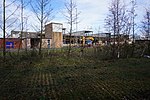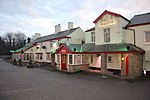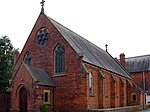Salwick railway station
DfT Category F2 stationsFormer Preston and Wyre Joint Railway stationsNorthern franchise railway stationsPages with no open date in Infobox stationRailway stations in Great Britain closed in 1938 ... and 4 more
Railway stations in Great Britain opened in 1840Railway stations in Great Britain opened in 1940Railway stations in the Borough of FyldeUse British English from September 2017

Salwick railway station is situated on the Preston-to-Blackpool railway line in England, 5+1⁄4 miles (8.4 km) west of Preston, and is managed by Northern. The station lies between Preston and Kirkham, near the village of Clifton. The station was closed on 2 May 1938 along with Lea Road railway station to the east, but was reopened on 8 April 1940 to serve the adjacent industrial complex.Lancashire County Council has pledged to construct a new station at nearby Cottam which may require the closure of Salwick as referred to at page 38 of the Central Lancashire Highways and Transport Masterplan.
Excerpt from the Wikipedia article Salwick railway station (License: CC BY-SA 3.0, Authors, Images).Salwick railway station
Station Road, Borough of Fylde Newton-with-Clifton
Geographical coordinates (GPS) Address External links Nearby Places Show on map
Geographical coordinates (GPS)
| Latitude | Longitude |
|---|---|
| N 53.7819 ° | E -2.8195 ° |
Address
Salwick
Station Road
PR4 0XJ Borough of Fylde, Newton-with-Clifton
England, United Kingdom
Open on Google Maps









